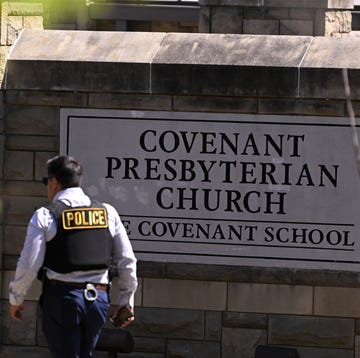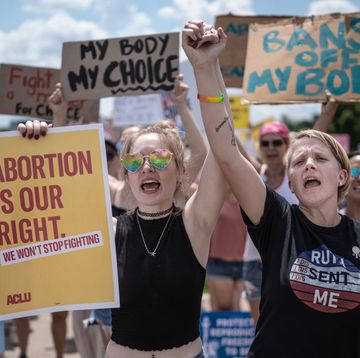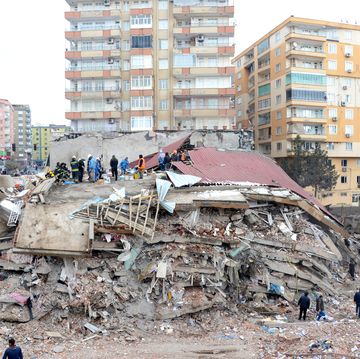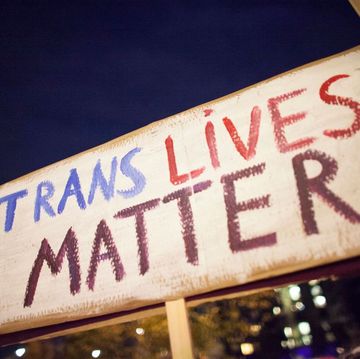It is often said that children are our future. Yet, despite all the progress that has been made in recent years to lay the groundwork for a better and more equitable one, Americans still cannot always protect our children from abuse or save them from trauma. All we can do is advocate to ensure the law holds their well-being in mind, educate families about abuse detection and prevention, and jump into action when things do go wrong.
Balenciaga has partnered with the National Children’s Alliance in pursuit of that mission. After two campaigns by the fashion house last fall were met with widespread controversy and concern due to the inclusion of children in one of them, Balenciaga issued a public apology and vowed to learn from and highlight the crucial work of the NCA, which includes providing professional services to remove kids from abusive situations and to help them heal from trauma. Thanks to support from the brand, NCA will be able to train almost 2,000 specialists over the next three years, helping up to 55,000 children get access to the kind of mental health care they need.
Bazaar.com sat down with NCA chief executive officer Teresa Huizar to discuss the nonprofit’s important partnership with Balenciaga and learn more about the work her organization does.
More From Harper's BAZAAR

Tell me a little about the work you do and why it’s more important than ever post-pandemic?
Well, as you know, National Children’s Alliance is the national association and accrediting body for children’s advocacy centers across the country; those centers work with children who have been abused or experienced some other form of trauma—but mainly child sexual abuse. And one of the things that we know post-pandemic is that there has been a mental health crisis for children.
We know that children had additional risk during that time, both in terms of being home with potential abusers, or being in alternate environments while school wasn’t in session in person. So, because of that, what we have seen post-pandemic is children moving forward and disclosing abuse. And online exploitation also exploded during that time. So there is an intersection of many factors that make this a particularly challenging time to be a child, and also a particularly challenging time to be a parent.
How can kids in need get access to the NCA’s services if they’re not brought in by a guardian?
In general, children who come to children’s advocacy centers are referred through a report of alleged abuse. That could come from law enforcement or Child Protective Services or someone else.
Their initial contact with the children’s advocacy center may be around the actual investigation, to be interviewed by a trained forensic interviewer who knows how to talk to kids in a way that’s not traumatizing, making sure they get a medical exam, those kinds of things.
But at the same time, if they have been abused, and certainly if they have any trauma symptoms, they’re going to get a trauma assessment, they’re going to be screened to see what mental health services they need and then referred into treatment. Children’s advocacy centers around the country have staff on site, but also have very close partnerships and written memorandums of understanding with community providers, because specialty care can be diverse in terms of the mental health needs of kids.
We have found that parents tend to be more willing to take their children to therapy at a children’s advocacy center after they’ve already received some services there, and that is because while there, people are treated in a really respectful, kind, supportive, and thoughtful way. And that builds a level of trust.
What are some obstacles you face in those early steps, when meeting families?
I think that we have to keep in mind that it’s our job to lower barriers for families accessing treatment—whether that’s barriers like needing child care, or having a long commute, or having transportation issues. Or whether it’s a perceptual barrier—just worried that it won’t work or be effective, or they’re not sure what they think about it, or maybe there’s a stigma still attached to that in their own cultural setting.
The way we think about it is if a parent is bringing their child to one of our children’s advocacy centers, they are already getting a star in the parenting department, because they’re seeking help. That is the first step and it’s so critical. We know that parents sometimes do feel a sense of guilt or shame about seeking services, and I think all of us in human services, it’s our job to just be really reassuring to parents and clear that they’ve made a good decision on behalf of their child.
What kind of results have you seen?
We see almost 400,000 kids a year and collect a lot of data about this. We have an outcome measurement system in which both caregivers and older children directly tell us about their experience. The kind of things they write are just amazing; kids have such a clear sense of what helps them and what doesn’t. And we take this feedback very seriously.
We make it available to our specialists in real time, so they can see if there’s an area they need to improve on. Let me give you an example of that: Kids seem to be very attuned to the physical environment, and we’ve had more than one kid who’s commented, “It’s too quiet.” Think of when you walk into a library or a museum—if it’s too quiet, you can feel uncomfortable. And so that’s an easily correctable thing.
We also try to capture trauma assessment results at the beginning of treatment, at the middle, and at the end, because we want to make sure that the treatment is actually working—and if it’s not, that we’re adjusting the treatment. With these results, you can often see that kids have a sharp drop in their trauma symptoms to below clinical levels.
Now, you might say, “Well, that just kind of sounds like a lot of therapy speak. What does that mean for kids and families?” What it means for kids and families is that kids are able to sleep through the night, no night terrors, they’re not hypervigilant all day at school, they’re able to focus on learning. You tend to see their school performance go back up. They’re not fighting at home with siblings nonstop and acting out because they’re really trying to distract themselves from the distress they’re feeling. When we think about what we want for kids, it’s not just that their score is better on a clinical measure—it’s that their daily life has improved and they can focus on the job of being a kid instead of thinking 24/7 about the trauma they’ve experienced.
I’m sure you’ve seen so much trauma with the ongoing school shootings.
Yes, and children's advocacy centers have been on the front lines of responding, because in most communities, they are the only folks who are experts in trauma of any type. If you look at Newtown, Connecticut or at Uvalde or many other locations, it’s [the children’s advocacy center’s] therapist who has been providing therapy to those kids, it’s their forensic interviewers who have interviewed the kids who witnessed the incident; they’re not just being interviewed by whatever random law enforcement. So it’s interesting you mention that, because sadly, that has had to be added to our portfolio of work.
I know it’s very broad because there are so many different types of trauma, but what are some of the signs that parents can look out for in their kids?
You’re really looking for significant changes in behavior. Maybe you’ve had a straight-A student and now they’re getting Cs, Ds and Fs. That’s a big shift that should raise—not an alarm that it’s a specific type of trauma they’ve experienced, but it’s something that should alert parents to the fact that their child may be needing some additional support, and it might not just be academic support. Or, if the child is reporting that they’re having nightmares a lot. A parent may think their child is having nightmares once a month, but the child may be experiencing them every night as night terrors that are keeping them up, just because the kid feels uncertain about continuously waking up their parent or talking to them about that. It’s these patterns of unusual behavior that should act as a red flag.
As an adult without children, I initially assumed that, because there’s so much information and help out there that kids are able to access, cyberbullying would have decreased or the effects of it would be less problematic than before, when there was less access. But I saw your data, and that doesn’t seem to be true at all.
I wish it were, but no. If you think about it, there are constantly evolving and new platforms, there is constantly the creation of new social communities or social groups, new apps, gaming platforms. And so I don’t really think that we’re going to see a precipitous drop-off any time soon, because the metaverse continues to explode and technology will continue to advance. I think it would take a significant shift, culturally, to see a huge decrease.
What I think can happen, though, is that we can open a door to prepare children for what being online is like. I think that for many parents who are in their mid-30s to their 50s or beyond, they may not really have thought much about what the experience is for kids today.
There’s this sort of default assumption that it’s a safer environment than it actually is, and I think we need to turn that on its head and not terrify parents or be alarmist, but say in the same way that parents talk to their children from their earliest days about all kinds of safety things—look both ways before you cross the street, etc.—this is one that needs more attention than it’s getting, for parents to really prepare kids for the full range of safety issues that could come up online. Cyberbullying is one, but there are many others—extortion, online exploitation.
Do you guys teach parents how to have those conversations?
Our children’s advocacy centers do a lot of caregiver education as a part of their child abuse prevention efforts and cover a range of topics. I would say they are coming very recently to the topic of cyberbullying, and the reason for that is they started in prevention presentations to talk about child sexual abuse, and that led them to sextortion, and that led to other forms of online exploitation, and problematic sexual behaviors in youth, and then cyberbullying—because it turns out that a significant percentage of kids who cyberbully others may be doing other delinquent things online and offline, including acting out sexually with other kids. So it’s one of those things that even for our own movement, we’ve kind of had to catch up to technology, too.
Part of what we need to do and part of what I am really excited about [for] this Q&A and this partnership with Balenciaga is being able to help caregivers and parents have an entry point into that conversation and make it seem very normal to have on a regular basis.
We’re launching some pages on our website that parents and others can also access about cyberbullying, and some child-service professionals are out there at schools educating elementary, middle, and high school kids, where so much of that education needs to be.
What is the biggest challenge you’ve seen in your years with the NCA?
The NCA has been around since the late ’80s, and I’ve been here for 15 years. Before that, I was a children’s advocacy center director of two different CACs myself, so I was right down there in the trenches.
I think the biggest challenge I’ve faced is the one we’re working on right now, which is expanding mental health care access to every kid who needs it.
While 250,000 kids a year get mental health treatment through children’s advocacy centers around the country, we know there’s a gap of about 80,000 who don’t—there just simply aren’t enough clinicians trained in evidence-based treatments to treat those kids. And so a big part of this initiative with Balenciaga has been around closing that gap, and it’s an important one to close, because children’s advocacy centers do not take a parent’s ability to pay as a consideration in offering the services. Most of them do not accept third-party billing, so that they can provide the service exactly as needed. And they’re not charging the parents or anyone else for that, they’re fundraising privately to cover it.
But there have to be enough clinicians who are trained in this, and so over the course of this partnership, we’re training about 2,000 clinicians and other providers—who, by the end of a three-year period, should be closing that gap by about 55,000 kids. That still leaves us with way too many who won’t have access. I hate the thought of there being 30,000 kids a year still, even at that point.
But thinking about this massive effort that we, as a nonprofit, are making—frankly in a country that does not have universal health care—to close the gap, we’re so grateful to have a partnership that helps us to do that in such a significant way.
Speaking of the partnership with Balenciaga, why was it right for you and how did it come about?
I felt from early conversations that they were genuinely in a teachable moment and interested in issues around child protection and had values that aligned with ours around that. That may sound a little unusual, given some of what happened last fall, but what I have learned through this and working with them—and they’ve been fantastic partners—has been that we sort of assume in children’s advocacy work that everybody knows everything there is to know about these topics, and the fact of the matter is people don’t. And when you share with them the scope of the problem and when you share with people that there’s something they can do to help, they often want to. And Balenciaga really did. They saw that when we talked about the work of our NCA Institute for Better Mental health outcomes, what could be done to close that gap. They were really interested in doing that.
And what we are interested in doing is closing the gap, but also opening a larger conversation within the fashion industry about how children are supported, how we get a message out to a larger audience. In one of our early conversations with them, they said, “We’re just shocked by the numbers you’re talking about. Why is it more people don’t know these things?” And we said, “We’ll tell you why, it’s because subject-matter experts like us have a very small voice into popular culture. And companies like yours have a megaphone into popular culture, but you don’t know anything about the topics we’re talking about.”
So for us, this felt like a really important partnership in which we could provide valuable information, not just to Balenciaga and not just to their followers, but really to the general public. And we’re so happy to have Harper’s Bazaar’s desire as part of the issue, because you have a whole other megaphone into a whole other aspect of the general public.
To have a major corporation as an ally, saying, “You’re not alone. We’re with you. We stand beside you,” is so powerful to survivors, to people who've been bullied, but also to people who’ve experienced other forms of exploitation or abuse. So let me just say that your allyship is as critical as anything else that’s being done as a part of this partnership.

Rosa Sanchez is the senior news editor at Harper's Bazaar, working on news as it relates to entertainment, fashion, and culture. Previously, she was a news editor at ABC News and, prior to that, a managing editor of celebrity news at American Media. She has also written features for Rolling Stone, Teen Vogue, Forbes, and The Hollywood Reporter, among other outlets.














